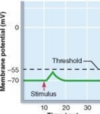Bio: Ch 1, 4 Flashcards
(233 cards)
cell theory
- all living things are composed of cells
- cell is basic functional unit of life
- cells arise only from preexisting cells
- cells carry genetic info in the form of DNA
- this genetic material is passed on from parent to daughter cell
why are viruses not considered living things?
- acellular
- cannot reproduce without the assistance of a host cell
- may use RNA as their genetic material
eukaryotes
have membrane-bound organelles, a nucleus, and may for multicellular organisms
prokaryotic cells
do not have a nucleus
membranes of eukaryotic cells
phospholipid bilayer, which organize to form hydrophilic interior and exterior surfaces with a hydrophobic core
cytosol
suspends the organelles and allows diffusion of molecules throughout the cell
nucleus
contains DNA organized into chromosomes
nuclear membrane/envelop
double membrane that contains nuclear pores
double membrane maintains a nuclear environment separate and distinct from the cytoplasm
nuclear pores
in nuclear membrane
allow selective two way exchange of material between the cytoplasm and the nucleus
genes
coding regions in DNA
histones
orgnaizing proteins that linear DNA is wound around
nucleolus
subsection of the nucleus in which ribosomal RNA is synthesized
mitochondria structure
- two layers
- outer membrane
- inner membrane that is folded into critae
- intermembrane space
- matrix

outer membrane of mitochondria
barrier between cytosol and inner environment of the mitochondrion
inner membrane of mitochondria
- arranged into infoldings called cristae
- contains the molecules and enzymes of the ETC
cristae
infoldings in inner membrane of mitochondria
increase the surface area available for ETC enzymes
intermembrane space
space between inner and outermembranes of mitochondria
matrix
space inside the inner membrane of mitochondria
how are mitochondria different from other parts of the cell?
- semi autonomous
- contain some of their own genes
- can replicate independently of the nucleus via binary fission
- can trigger apoptosis by releasing mitochondrial enzymes into the cytoplasm
cytoplasmic or extranuclear inheritance
transmission of genetic material independent of the nucleus
apoptosis
programmed cell death
lysosomes
contain hydrolytic enzymes that can break down substances ingested by endocytosis and cellular waste products -> when these enzymes are released, autolysis of the cell can occur
often work in conjunction with endosomes
endosomes
transport, package, and sort cell material traveling to and from the membrane
can transport materials to the trans-golgi, cell membrane, or to the lysosomal pathway for degradation
autolysis
released enzymes lead to the degradation of cellular components -> apoptosis
























